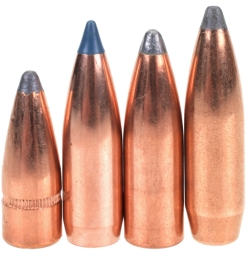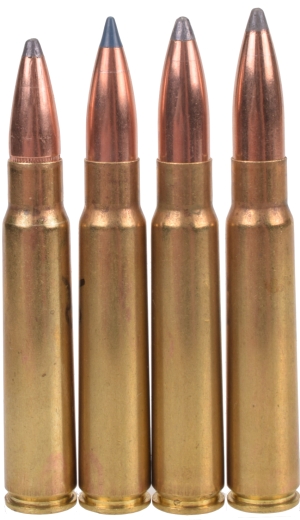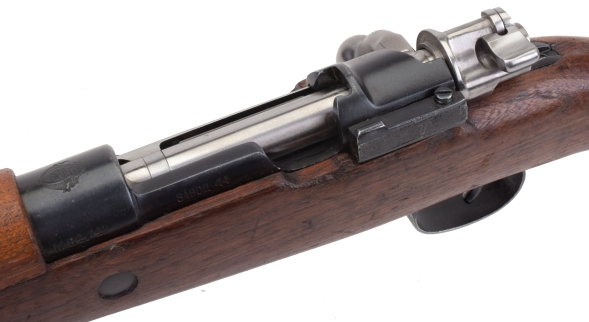My wife’s birthday is this Friday and she said she would like to go out to dinner at a local Mexican restaurant. Unfortunately, the restaurant does not take reservations, the place is mobbed with turistas who are in search of… authentic Maine Mexican food, and the summer help service is terrible. I realize my wife does not really want to go, but if she can get me to say, “No”, I will owe her one and she will wield the power of guilt. If I say “Yes”, she will feign elation and then hide both of my good t-shirts, causing me to cancel dinner, and I will still owe her one and she will still wield the power of guilt… which is what she really wanted for a birthday gift. Life does not always move in a straight line.

Before firing a rifle, and as part of a periodic inspection, headspace should be checked. If it is good, a cartridge will be properly supported and its case will not stretch significantly when fired. If headspace is below minimum spec, there is no assurance a round will chamber. This could be a big deal if you’re hunting brown bear, you shoot and miss, he takes exception to your overture, and you can’t chamber a second round. Too much headspace and chamber pressure will stretch out a cartridge case until it fails in the form of case head separation, or fractured neck or shoulder, and your face and/or hands get a dose of hot brass and powder residue, propelled by 50k+ psi pressure.
The chamber specs for the 8x57mm Mauser chamber specs have changed over the years, particularly in regard to shoulder angle. CIP’s current junction cone spec, the angle of both shoulders, is 38°12’06” for the cartridge and 38°19’59” for the chamber. The SAAMI spec is associated with a single shoulder angle, rather than junction cone, and is approximately half of the CIP equivalent method; 20º48′ cartridge with a headspace dimension of 1.8786″ – 0.007″ and 19º chamber with a headspace dimension of 1.8843″ – 0.010″. The current CIP Pmax 3900 BAR (56,551 PSI) – For 0.323″ Groove Rifles Only. The current SAAMI MAP pressure spec for the 8mmx57mm is 35,000 PSI.
| Standard | Cartridge Junction Cone |
Chamber Junction Cone |
Cartridge Shoulder |
Chamber Shoulder |
Cartridge Headspace Length |
Chamber Headspace Length |
Pmax/MAP Pressure PSI |
| CIP | 38°12’06” | 38°19’59” | – | – | N/A | N/A | 56,551 |
| SAAMI | – | – | 20º48′ | 19º | 1.8786″ – 0.007″ | 1.8843″ – 0.010″ | 35,000 |
Prior to 1947, the Winchester Spec for the 8mm Mauser set the shoulder angle for both cartridge and chamber as 20º48′. The handloaders handbook of cartridge conversions sets the cartridge shoulder angle at 22º. Forster Products makes two different sets of headspace gauges, one for the old spec 20º48′ and one for the more recent 19º, suggesting that a chamber cast be made to determine which is correct. They further caution that using the newer spec gauge in the older chamber will result in the nose of the gauge hitting the rifle’s bore before the gauge seats at the correct location on the shoulder, causing the gauge to falsely check long… which is what happened with this M24/47.
| Gauge Type |
Foster # | Shoulder Angle |
Headspace Length |
Datum Point Diameter |
| Go | HG8mmoldG | 20° 48’ | 1.8960″ | 0.392″ |
| No-Go | HG8mmoldN | 20° 48’ | 1.9010″ | 0.392″ |
| Field | HG8mmoldF | 20° 48’ | 1.9050″ | 0.392″ |
| Go | HG8x57G | 19° | 1.8743″ | 0.392″ |
| No-Go | HG8x57N | 19° | 1.8803″ | 0.392″ |
| Field | HG8x57F | 19° | 1.8843″ | 0.392″ |
Since the headspace datum point diameter remains the same regardless shoulder angle, the headspace reference length changes accordingly as the case shoulder will contact the chamber at a different distance from the breech face. I tried both Go gauges and the bolt would not close over the newer generation headspace gauge with 19º shoulder. I applied some Prussian Blue to the end of the headspace gauges and found the old spec gauge contacted at the shoulder, but the new spec gauge nose bumped into the throat, did not touch at the shoulder and prevented the bolt from closing. So I went with the 20º48′ gauge set; the Go gauge cleared, the No-Go gauge did not.
As further verification that I was on the right track with the 20º48′ set, I used a Hornady Lock-N-Load headspace gauge to pull before and after headspace readings. Hornady does not make a gauge bushing for the 8×57 JS, or a modified case for that matter. I could have use a gauge blank and fabricated one, but because I was only checking relative change, I used an 0.375″ bushing that touched a little higher on the case shoulder. The results of 16 test cartridges looked like this:
|
Recorded Case Stretch Samples |
||||||||||||||||
| Cartridge # | 1 | 2 | 3 | 4 | 5 | 6 | 7 | 8 | 9 | 10 | 11 | 12 | 13 | 14 | 15 | 16 |
| Case length Sized | 1.888 | 1.890 | 1.889 | 1.889 | 1.889 | 1.890 | 1.890 | 1.890 | 1.889 | 1.889 | 1.889 | 1.889 | 1.890 | 1.890 | 1.890 | 1.889 |
| Case Length Fired | 1.889 | 1.890 | 1.890 | 1.891 | 1.891 | 1.891 | 1.891 | 1.890 | 1.891 | 1.890 | 1.890 | 1.892 | 1.890 | 1.890 | 1.890 | 1.890 |
| Change | 0.001 | 0.000 | 0.001 | 0.002 | 0.002 | 0.001 | 0.001 | 0.000 | 0.002 | 0.001 | 0.001 | 0.003 | 0.000 | 0.000 | 0.000 | 0.001 |
The fact that the Hornady sizer die is cut to 20º48′ and there was so little headspace change from sized to fired suggests die set, cartridge and chamber share a common 20º48′ shoulder angle.
Pressure… What ever happened to Billy Joel?
The pressure disparity between CIP and SAAMI is related to the 8mm Mauser originally being produced with a 0.318″ rifling groove diameter 8×57 J and later changed to 0.323″ diameter 8×57 JS. Out of concern for the 0.323″ bullet being forced through a 0.319″ bore, SAAMI and almost all U.S. manufacturers curb pressure to the SAAMI spec and caution handloaders ad nauseam. The result is a wheezing, anemic 8x57mm that is destined to be a substandard performer. Really unfortunate as the 8x57mm should be a relatively heavy hitter.
Military Mausers stopped even the infrequent use of 0.318″ groove barrels in 1903 and few M98 versions were produced with the smaller bullet diameter. Unfortunately, many factory and custom civilian firearms rifles and customs through the 1950’s were produced with the 0.318″ bore so it is always good to check groove diameter before loading up cases with buckets full of powder and attempting to drive a big peg down a small hole.
The subject rifle has an 0.323″ groove diameter. Having built, seen and shot sporterized military Mauser actions modified and rebarreled for just about any 30-06 Springfield length cartridge, I’ve not seen one have a problem as long as inspection showed the receiver to be in good shape, headspace was correct and handloads were kept to SAAMI spec pressure levels. In fact, one of my favorites was an M98 military action barreled for the 25-06 Remington, a cartridge with a 65,000 PSI MAP. The handloads presented top at 56,000 PSI in this rifle and that is the ceiling I use for the 8×57 Mauser.
Lots of good bullets… These are but four

| Bullet | Type | Weight Grains |
Length Inches |
COL Inches |
| Hornady Interlock 3232 | SP | 150 | 0.997 | 2.975 |
| Nosler Ballistic Tip 32180 | PTBT | 180 | 1.240 | 3.100 |
| Nosler Partition 35277 | SPFB | 200 | 1.240 | 3.100 |
| Sierra GameKing 2420 | SPBT | 220 | 1.379 | 3.140 |
These are all good bullets. The lighter weight for hogs and deer, the heavier for larger game like elk, moose and bear. They are all single core construction with the exception of the Partition which is of A Frame construction.
If these are not to your liking, there are thirty two bullet types/weights currently in production, spread over ten manufacturers, in weights from 150 to 250 grains.

With a once fired, neck sized case, Re17 and the 150 grain bullet, the assembly was routine. With a fresh full length sized case, careful assembly is required and the load is notably compressed. It is still the highest velocity, normal pressure combination I have encountered. The 8x57mm seems to like Re17 across the bullet weight spectrum and accuracy came with increasing bullet weight.
Warning: Bullet selections are specific, and loads are not valid with substitutions of different bullets of the same weight. Variations in bullet material and length will alter net case capacity, pressure and velocity results. Primer selection is specific and primer types are not interchangeable. These data represents maximum loads in our firearms and test equipment and may easily be excessive in other applications. All loads should be reduced by 5%, and developed following safe handloading practices as represented in established reloading manuals produced by component manufacturers. Presentation of these loads does not constitute a solicitation for their use, nor a recommendation.
|
||||||||||||||||||||||||||||||||||||||||||||||||||||||||||||||||||||||||||||||
|
|
||||||||||||||||||||||||||||||||||||||||||||||||||||||||||||||||||||||||||||||
A couple of things I can offer about this performance. At the top of the list is my new eyeglass prescription that has returned metallic sights to the list of things I can utilize with firearms. Big deal for me. The other is that the Mauser’s sights are excellent and precise, although for me only in contrast against light targets. My thought was that as an iron site rifle, the 220 grain performance was of great importance than lighter load performance. Based on these handloads, and prior work ups, I would label this a 2 to 4 MOA rifle depending on handload.
No Wiffle ball trajectory…
|
220 Grain Sierra GameKing +3″ Ordinate 258 Yards Point Blank |
|||||||
|
Yards |
0 |
50 |
100 |
150 |
200 |
250 |
300 |
|
Velocity – fps |
2568 |
2484 |
2402 |
2321 |
2242 |
2165 |
2090 |
|
Energy -ft.-lbs. |
3221 |
3014 |
2818 |
2632 |
2456 |
2290 |
2132 |
|
Momentum -lbs-sec |
2.50 |
2.42 |
2.34 |
2.26 |
2.18 |
2.11 |
2.03 |
|
Path – in. |
-1.5 |
1.4 |
2.8 |
2.8 |
1.1 |
-2.3 |
-7.5 |
The 8x57mm is no slough. It is a relatively flat shooting, hard hitting round. The table above suggests that even this old military clunker has the situation easily covered out to 300 yards.
And as we ride off into the sunset…
Good rifle, good accuracy, good reliability. It is also a fun rifle to take out and blast away with every now and then. So what is it that makes this my last military surplus Mauser? While it is good for its age, it could easily be replaced with any new $400 rifle chambered for the 308 Winchester. The new rifle would be made with better materials, more accurate and supported with a warranty. Nostalgia and a sense of history only goes so far.


Email Notification